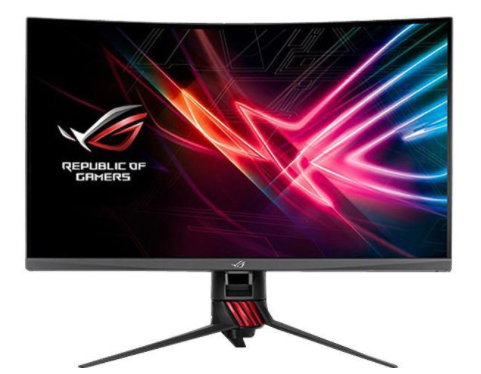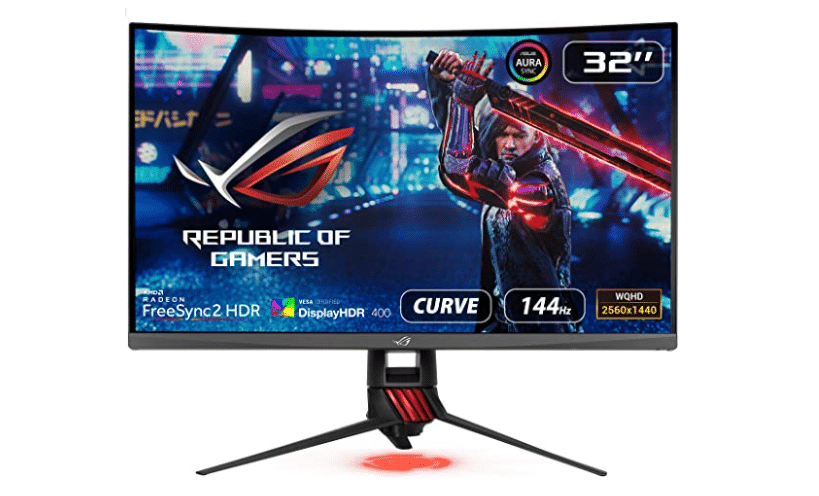5 Top Picks
4 Reviewers
30 Hours of Research
30 Options Considered
I was looking for the best 32 inch gaming monitor, when I came across an interesting piece of gear. Namely, the most expensive gaming monitor! It’s the HP - OMEN X Emperium. Which is a 65" affair with a 4K resolution, and a few more bells and whistles, reaching around $5000.
I juxtaposed its unbelievable specs with the jaw-dropping price, and made a decision. I seriously want a 32 inch monitor but not necessarily at that price. Not being an XBox fan, I only look for monitors for PS4. I'm not expecting to find a gaming monitor this size for under $100 or even under $400, but there are gaming monitors under 500 bucks, so no need to splash more. It’s easy to get starry eyed in front of top-tech stuff looking for the best gaming monitor, but as a hard core gamer, what do I really need? Maybe something from our BenQ monitor reviews? Read on to know all about it.
5 Top 32 Inch Gaming Monitors
[Best Overall]
Acer Predator XB321HK Widescreen 32 inch 4k monitor is made for high-end hardware. It takes full advantage of the high processor speed, graphic capabilities of NVIDIA, and the internal memory that supports 4K data.
4.9/5
[Best for the Money]
The BenQ EW3270U gaming monitor looks sleek, and sits majestically on the desktop. The fact that it has an extra high resolution motivated me to try it right away. I was wondering how the games I’m used to in 2K would differ in 4K?
4.8/5
[Best For The Design]
The BenQ PD3200U 4K monitor 32 inch display, is a no-nonsense serious guy. Here to do the work, not to flaunt frilly stuff. It offers picture-perfect imagery, practical connectivity, and efficient gaming performance across the board.
4.7/5
The Samsung C32HG70 32 inch 1440p monitor has a highly interesting design. It takes several important factors into consideration, and comes up with a fair compromise. The monitor is stable, adjustable, and still strives to look cool.
4.6/5
This is an innovative piece of gaming gear that feels like I’ve moved into a new and luxurious house. It’s one of the top gaming monitors around. Its 1800R curved panel spells out total immersion inside the game.
4.5/5
Features You Should Look for in a 32 Inch Gaming Monitor
When you’re in the middle of a game, what you really want is total immersion in the action. The commands flow from your fingers and in a blink of an eye they translate into a development in the game. You can see every single detail, and strategize accordingly. For maximum experience, check out the awesome curved gaming monitors we reviewed.
Start with the clarity of the image. Even if you lean sideways, and change your viewing angle, the game should remain sharp and comprehensible. That’s the screen resolution, pixel density, and panel type.
Then you’d like to have no stutter, so look for a high refresh rate and a quick response time.
Panel Types
There are three main types of panels, plus a futuristic trend:
Twisted nematic (TN)
In Place Switching (IPS)
Vertically Aligned (VA)
OLED
Each one gives you a benefit but comes with a downside. For example, TN is the oldest technology of panels, it has extensive development, and retails at budget monitor prices. TNs give the fastest response time of all panels, but the image quality isn’t awesome, and its viewing angles are rather limited.
IPS screens pop with color, but demonstrate noticeably slower response times. And if your scenes change too quickly, the frames might blur into each other. VAs are a meet-me-half-way option.
What about OLED, you might ask? That’s the fresh out of the oven tech worth a few thousand dollars.
Best 32 Inch Gaming Monitor Reviews
[Best Overall]
4.9/5
Acer Predator XB321HK Widescreen 32 inch 4k monitor is made for high-end hardware. It takes full advantage of the high processor speed, graphic capabilities of NVIDIA, and the internal memory that supports 4K data.
The result is a gaming monitor with a superb image quality, and a realistic gaming experience.
The looks come first, of course, and I do judge the book by its cover. Good aesthetics almost always carry on to good performance. This monitor is designed like an actual predator, with red highlights to further accentuate these wild lines. The gaming experience for the predator starts even before the device is turned on.
Features
- The design concept of the predator is perfect for gaming
- 4K UHD images are sharp and cinematic
- Supports 16.7 million colors for a realistic visual experience
- Adjustable height and tilt provides good ergonomics and comfort
- No flicker allows for easy viewing and longer gaming
- G-Sync NVIDIA tech eliminates tearing and other image lags
Acer Predator XB321HK Widescreen Display Specifications
Screen Size | 32 inch |
Panel Type | AHVA IPS |
Resolution | 3840 x 2160 |
Aspect Ratio | 19:9 |
Response Time | 4 ms |
Refresh Rate | 60 Hz |
Pixel Density (PPI) | 137 |
Getting to the juicy details now. The IPS panel is faultless. It supports millions of colors, has a high pixel density, and a wide dynamic range. The contrast and brightness don’t claim to use any AI gadgets to optimize, but their overall quality is great. Both in a well-lit room, or in darker surroundings.
The effects of the sun as it rises behind a lake, or in the middle of noon as it reflects on a building's windows is simply awesome. A relic scene with a thousand little caves where danger is lurking looked absolutely sharp with all the details fully exposed. And as my bugatti races through the ever changing streets of the city, the journey is a soft dream.
The response time is amazing with the 4-ms reaction. The refresh rate didn’t seem to catch up though, as its native refreshing rate is close to 60 Hz. However, it clocks up to 180 Hz, which more than makes up for the difference. And it didn’t compromise image quality as I stepped things up. It’s not constantly required though.

The adjustability of the predator exceeds the ones I saw before, with the angles changing from 5 to 25 degrees, and the height adjustable through a 5-inch range. This allows for customizing the gaming monitor to the way I sit, and the longer gaming hours went like a breeze. No aching or eye strain at the end of the racing marathon.
Finally, the audio. The built-in speakers could easily make one forget to connect the external boosters. They’re good, and the sound coming out of them is neither tinny nor weak. It’s actually well-defined and matches the action just fine.
The Predator 32" 4k monitor is a bit pricey, and this is a well known fact. Yet, it’s still among the best sellers, and there’s a reason for that. It’s designed purely for gaming.
Acer Predator XB321HK Widescreen Display Pros
Acer Predator XB321HK Widescreen Display Cons
[Best For The Money]
4.8/5
The BenQ EW3270U monitor looks sleek, and sits majestically on the desktop. The fact that it has an extra high resolution motivated me to try it right away. I was wondering how the games I’m used to in 2K would differ in 4K?
The optimized 4K UHD does look stunning. Especially when there are scenic landscapes and long exploratory narratives in the game. It’s easy to lose track of time when the images look that crisp and real. It’s actually one of the best 32 inch 4k monitors.
Features
- Amd FreeSync eliminates stuttering and enhances the game flow
- High color accuracy lets you see the games exactly as they were designed
- It has a low input lag time of 9.5 ms which enhances real time gaming
- Flicker-free and low blue light for eye comfort
- The 4 ms response time minimizes ghosting and other defects
- USB-C Single Cable Connectivity for a less cluttered desktop
BenQ EW3270U Monitor Specifications
Screen Size | 31.5 inch |
Panel Type | VA |
Resolution | 3840 x 2160 |
Aspect Ratio | 16:9 |
Response Time | 1ms |
Refresh Rate | 60Hz |
Pixel Density (PPI) | 140 |
The colors pop when the room is well lit, but things start looking much too bright if the room is dark. This isn’t a huge deal, especially if you prefer having sufficient lights around you.
The brightness intelligence plus feature seems to work great on paper, but a little less optimally in the real world. Typically, it’s supposed to detect the ambient lighting in addition to the screen content. Then, it supposedly adjusts multiple settings in the screen for the most comfortable visual experience.

It retails at a decent price currently, which is much more fitting for its true value. This good gaming monitor comes after the initial higher price that BenQ suggested at the outset. In my opinion, this will popularize the 4K displays tremendously moving forward.
BenQ EW3270U Monitor Pros
BenQ EW3270U Monitor Cons
[Best For The Design]
4.7/5
The BenQ PD3200U 4K monitor 32 inch display, is a no-nonsense serious guy. Here to do the work, not to flaunt frilly stuff. It offers picture-perfect imagery, practical connectivity, and efficient performance across the board.
The appearance of this gaming monitor doesn’t sing and dance gaming, a 32 inch computer monitor, but it does have its charms as an elegant device. Simple and chic.
Features
- Stable base for safe placement
- Space economy with the efficient frame design
- The 4K UHD and color technology give superb cinematic image
- Even visibility at all viewing angles provide more seating options
- The KVM switch connectability decreases desk clutter
- Low blue light, flicker-free tech, and animation mode make viewing easier on the eye
BenQ PD3200U Monitor Specifications
Screen Size | 32 inch |
Panel Type | IPS |
Resolution | 4K UHD (3840x2160) |
Aspect Ratio | 16:9 |
Response Time | 4 ms GTG |
Refresh Rate | 60 Hz |
Pixel Density (PPI) | 137.68 |
The base is quite stable, and in my opinion, this is among the features that many users need to check. A wobbly monitor is highly inconvenient, and stands the risk of falling. And that’s why many people opt for the wall-hanging models.
The base width also allows the screen support to push it back a bit more, freeing up your desk, and placing it at a comfortable viewing distance. And since we’re talking about comfort, we can just as well check out other screen adjustments.
The height, swivel, tilt, and pivot are all adjustable. And here’s my personal favorite; the screen can rotate 90 degrees, and go into portrait mode. This is seriously ergonomic design, and it tailors itself easily to any rig set up.

Now to the heart and soul of the monitor. The 4K UHD combined with the IPS panel and 138 DPI pixel density looks incredible. Every detail and color pops out. To explain the AQCOLOR technology, BenQ says that it would “make inspirations come alive”. I like that. Especially since I work and play games on the same monitor.
The speed response is not as powerful as the images, and I admit that I’ve seen better. The 4 ms response doesn’t match the 1 ms reflex of other models, and the 60 Hz refresh rate comes a bit slow at times. But it still performs well in FPS, racing, and sports action.
The KVM is another feature I really like. I could connect another screen, and operate everything from one keyboard and one mouse. This comes in sharp contrast with the mess I used to have before.
The BenQ regularly sells at a premium price tag, but I saw several cuts here and there, and it’s actually offered at quite competitive figures in several places. I believe that this would boost the appeal of having a 4K 32 inch gaming monitor to many gamers.
BenQ PD3200U Monitor Pros
BenQ PD3200U Monitor Cons
The Samsung C32HG70 32 inch 1440p monitor has a highly interesting design. It takes several important factors into consideration, and comes up with a fair compromise. The gaming monitor is stable, adjustable, and still strives to look cool. While it’s not exceptional in any single one of these attributes, it does provide a good mix of all three.
Features
- QLED optimization for a unique image quality
- High refresh rate and low response time are optimal for speed games
- Adjustable height and screen angle for comfort
- AMD Radeon FreeSync 2 support enhances gamingperformance without image degradation
- High pixel density gives sharp details
- Arena lighting projects interesting light patterns to the back wall
Samsung C32HG70 Curved Gaming Monitor Specifications
Screen Size | 31.5 inch |
Panel Type | SVA |
Resolution | 2560 x 1440 |
Aspect Ratio | 16:9 |
Response Time | 1 ms MPRT |
Refresh Rate | 144 Hz |
Pixel Density (PPI) | 93 |
The ergonomics of this monitor are pretty cool. The height is adjustable from 19.2-25 inches, which is for me a wide range up and down, that’s generous!
The angle of the screen is easily changeable, and goes from -5 to 15 degrees vertical, plus a 90 degrees rotation. Again, this is more than what I need, but I’m sure there’s a gamer out there who would appreciate the added flexibility.
The connectivity of the Samsung is straight forward, with all the standard ports. There’s even a couple of 3.5 mm audio inputs, that I used to connect headsets directly to the monitor. The only thing that’s missing from that panel is the built-in speakers.

The placement of the ports at an extreme location at the rear is a bit odd, and can make connecting cables a little difficult. But it serves the aesthetics well, and if this panel is not in use, there’s a snap-on cover that conceals it from the world entirely.
Moving on to the good stuff. Samsung advertises an eye-catching statement, that this curved monitor “has 1 billion color support” thanks to its QLED technology. I haven’t counted, but I noticed right away the vivid colors and the prime quality images.
To check the monitor’s performance when speed is required, I picked a couple of particularly needy racing and FPS games. The 1 ms response time, plus the 32 inch 144hz monitor’s refresh rate, along with the premium images, took playing games to a whole new level.
This 4k gaming monitor comes at a moderate price, which is now more realistic after the recent discounts. All things considered, the Samsung is one of my personal favorites.
Samsung C32HG70 Curved Gaming Monitor Pros
Samsung C32HG70 Curved Gaming Monitor Cons
The Asus ROG Strix XG32VQR 32 inch gaming monitor 144hz, is an innovative piece of gaming gear that feels like I’ve moved into a new and luxurious house. It’s one of the top gaming monitors around.
Its 1800R curved panel spells out total immersion inside the game. And with its 4 ms response time and 144 Hz refresh rate, I was playing in real time.
Asus ROG Strix XG32VQR Gaming Monitor Specifications
Screen Size | Wide Screen 31.5 inch |
Panel Type | VA |
Resolution | 2560 x 1440 |
Aspect Ratio | 16:9 |
Response Time | 4ms (Gray to Gray) |
Refresh Rate | 144Hz |
Pixel Density (PPI) | 93 |
There are a few points that fell short of my high expectations, but nothing too dramatic. It’s still one of the best 32 inch gaming monitors out there.
As I unboxed the monitor, I knew that I’d be greeted by a pretty device, this is Asus we’re talking about here. And the ROG Strix definitely didn’t disappoint, as it comes with some of the best aesthetics in the market.
The RGB lights on the rear and stand are elegant and respond well to my mood. They aren’t intrusive or distracting in any way. This is the case when some designers add too much salt, by including disco lights instead of RGB effects.
There’s also that awesome ASUS Aura Sync lighting technology. It connects easily to my laptop, or any other Aura-enabled gadgets, to create the coolest battlefield ever. In addition to that, the light signature is customizable to project various impressive desktop enhancements.
The wire guide in the stand caught my attention too. It’s not very often that I see such thoughtful gestures. Moving the cables out of the way and passing them in an organized manner over my desk is much appreciated. Moving on to the actual display. I just displayed an uncomplicated sequence of night scenes to test the elementary stuff. QHD/2K is a great tech, especially since I haven’t been glued to a 4K display for any extended amounts of time. VA works just fine, but the viewing angle at the extremities is slightly less glam.

The flicker-free technology was evidently working, and there’s definitely a noticeable change between the unstable images caused by flicker, and the tranquil new ones. Flickers can give you a headache and damage your sight, hence buy the best monitor for the eyes.
I checked out the shadow boost feature next, but quite honestly, I didn’t feel much difference. Maybe I wasn’t using media with enough contrast variation between light and dark areas. Well, in theory it should give extra detail in the darker areas, without messing with the overall brightness. Should be good.
The actual gaming reveals the next set of attributes best. So I selected a bunch of racing, FPS, and strategy titles. They’re all brand new, so I know they have high demands on gear and hardware.
The image quality is superb. And the landscapes didn’t suffer from the stutter, blur, and tear my old-timer used to have. The 144 Hz is sharp as a whip and never misses a beat, this is a plus for the Asus. The 4 ms is also perfect timing. I played an uninterrupted game that I enjoyed plenty.
I tried my hand with the FreeSync 2 HDR technology to see if it would make a good thing better, but there was a catch. It did boost the speed performance, but the image started showing leaks here and there.
I’ll be more specific and name names here. The contrast, brightness, and to a lesser extent sharpness showed some fatigue. Not too significant though. Definitely not a deal breaker.
As expected, the price is higher than the midrange. But all things considered, it’s worth the extra bucks.
Asus ROG Strix XG32VQR Gaming Monitor Pros
Asus ROG Strix XG32VQR Gaming Monitor Cons
Refresh Rates
The refresh rate is how many times the screen is repainted per second. The standard for regular LCDs is 60 Hz, which means that the display is reset 60 times each second.
The new information that comes from the CPU keeps updating at this rate to give viewers a cinematic experience. In a game, this shows how smoothly you proceed throughout the narrative.
Stuttering, tearing, ghosting, freezing, and blurring, are unpleasant visual phenomena resulting from poor refresh rates. Going for 120 hz, 144, or 240 Hz refresh rates creates much smoother frame transitions. Still, it needs additional tech to give a blemish-free performance.
The 144hz gaming monitor is among the most popular choices, while a 240hz gaming monitor is harder to come by.
Response Time
This feature goes hand in hand with refresh rate, as it directly impacts motion-blur. The response time is how long it takes a pixel to change color from black to white. Alternatively, it’s measured as the pixel changes between shades of grey.
TN panels have swift response times of as low as 1ms, while IPS panels often go with 4ms. Generally, you wouldn’t notice the difference between both, unless someone points it out. Still, gaming monitors should be swift responders.
Screen Resolution
This is another parameter that gamers take note of. A high resolution 32” monitor means a pleasant image quality and sharp details. No gamer can go without these options. There are a few discrete resolutions we often come across in gaming monitors.
HD/720p: 1280 x 720
Full HD: 1920 x 1080
QHD/2K: 2560 x 1440
UHD/4K: 3840 x 2160
5K: 5120 x 2880
You’d want to go with the best 4k gaming monitor. But here’s the catch, can your hardware match its power? I often go with my current rig’s capabilities, like opting for a 1440p gaming monitor. If I plan to upgrade soon, I buy an advanced monitor accordingly.
Image Quality
Image quality comes from the way all the various parameters integrate together. As an example, the monitor’s resolution could be outstanding, but if the size is too big, then the image would be pixelated.
That’s why we take pixel density into consideration as well. A monitor with packed pixels renders much sharper images.
In addition to the previous points, there are other aspects that complement the image quality. Contrast, brightness, color dynamic range, and synching are all factors that differentiate one monitor from the next.
Sometimes, getting a fast response time, higher refresh rate, or a wider range of viewing angles compromises image quality. Gaming monitors are full of trade-offs.
FreeSync and G-Sync
Using the Synch tech is a neat trick to reduce screen tearing and stuttering in images. Both methods have a similar performance, with some branding differences.
FreeSync monitors work with AMD graphics cards, and you don’t pay anything extra. While G-Sync monitors are compatible with NVIDIA graphics, and often come at an extra cost.
Lastly, synching is great for a smooth action, but affects brightness.
FAQs:
1. Is 32 inch monitor good for gaming?
Yes, a 32-inch monitor is an excellent choice for gaming. While some people prefer 24-inch monitors, others believe that even a 27-inch display is too small. 32-inch monitors are typically considered too large for gaming by the majority of people. Whichever display size you prefer, you should always bear in mind the screen resolution.
2. Which is the best 32 inch gaming monitor?
Here are the top 32 inch gaming monitors that we can recommend.
1. Asus ROG Strix XG32VQR Gaming Monitor - The Asus ROG Strix XG32VQR 32 inch gaming monitor 144hz, is an innovative piece of gaming gear that feels like I’ve moved into a new and luxurious house. It’s one of the top gaming monitors around.
2. BenQ EW3270U Monitor - The BenQ EW3270U monitor looks sleek, and sits majestically on the desktop. The fact that it has an extra high resolution motivated me to try it right away. I was wondering how the games I’m used to in 2K would differ in 4K?
3. Samsung C32HG70 Curved Gaming Monitor - The Samsung C32HG70 32 inch 1440p monitor has a highly interesting design. It takes several important factors into consideration, and comes up with a fair compromise.
3. Is 32 inch too big for 1440p gaming?
For pure gaming enjoyment, especially when using wireless peripherals, large +32 inches displays are fantastic. In terms of resolution, 1440p on a 27 inches display appears to be quite sharp. 32-inch would be preferable if your eyesight is prone to fatigue or if you prefer larger fonts on-screen without sacrificing screen area.
4. Is QHD good for 32 inch gaming monitor?
We believe a 32-inch QHD display is excessively pixelated. If you're primarily concerned with display size, 4k will look fantastic on a 32-inch monitor. At 32-inch, QHD has the same pixel density as FHD (The most common monitor size nowadays).
5. How far should you sit from a 32-inch monitor?
To protect your eyes and reduced the eye strain it as advisable when using a 32-inch QHD monitor, the ideal distance increases slightly from 80cm to 96cm, and the maximum length increases to 1.3 meters (4.5 feet)











